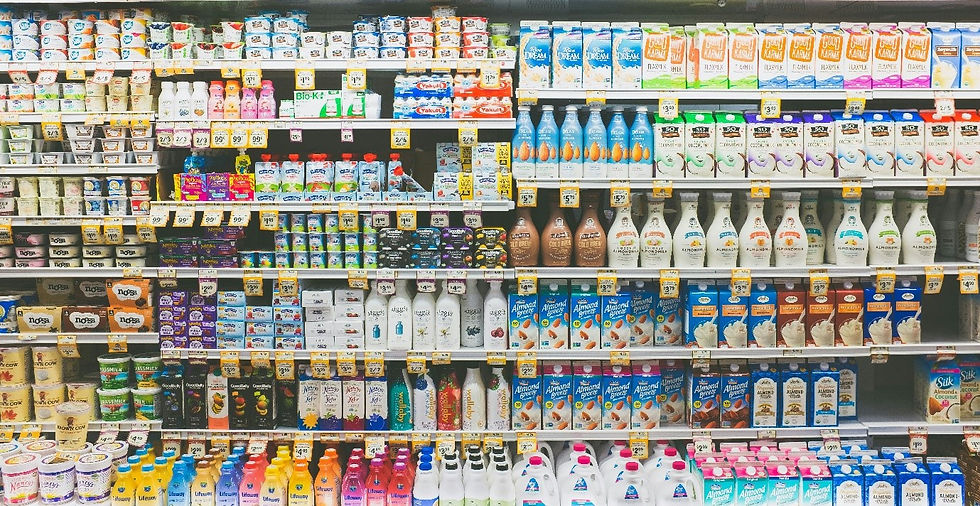Exploring the Impact of Packshot Aspects on Customer Buying Intentions
- Lisette Kruizinga-de Vries

- Sep 30
- 4 min read
Blog post by Lisette Kruizinga – de Vries, based on the master thesis of Ny Thi Ha Dao (University of Groningen)

Introduction: Why Packshots Matter
Among the various elements of product visuals, packaging design plays a critical role in attracting customer attention. Packaging is the first aspect consumers notice and often serves as the initial factor they use to evaluate a product before making a purchase decision (Ahmad et al., 2012). Beyond its primary function of protecting the product, packaging has evolved into a marketing tool that quickly communicates the product’s value at the point of sale.
When packaging aligns with customer preferences, it can effectively stand out on the shelf, build a connection with the brand, and increase purchase intent (e.g., Hubert et al., 2013; Spence, Velasco, & Petit, 2019). These findings highlight the crucial role of packaging in fostering customer engagement and driving purchasing behaviour.
With only seconds to capture a shopper's attention, packshots must deliver more than brand identity—they must inform, engage, and persuade. A recent thesis from the University of Groningen, conducted in collaboration with DVJ Insights, sheds new light on this topic. By combining consumer survey data with AI-predicted engagement scores, this study investigates what truly makes a packshot influence buying intention. More specifically, it answers the following research question:
What aspects of online packshots influence customer purchase intentions, with engagement (predicted by AI) as a mediator?
Theoretical Background: From Attention to Intention
Historically, packaging has been understood as both a protective and promotional tool. In offline settings, distinctive packaging has long been tied to brand recognition and purchasing behaviour. However, in the digital environment, consumers rely heavily on visual cues, as they cannot physically interact with the product.
Building on the Theory of Reasoned Action (Fishbein & Ajzen, 1975) and the Theory of Planned Behavior (Ajzen, 1991), this study explores how attitudes and evaluations formed by viewing packshots translate into behavioural intentions—specifically, the intention to purchase. It also probes the role of engagement, a psychological state characterized by interest, attention, and emotional resonance, which is believed to mediate the link between visual stimuli and consumer decision-making.
The study proposes that five packshot elements influence engagement and buying intention:
Instant Appeal – the first impression or visual attractiveness
Brand Identification – ease of recognising the brand
Distinctiveness – uniqueness relative to competitors
Informativeness – clarity and completeness of information
Product Clarity – visual clarity of product benefits and contents
AI-driven assessments of the degree of engagement provided by a packshot, based on the amount of positive associations a packshot is predicted to evoke based on its visual characteristics, was tested as a potential mediator in this process.
How the Study Was Conducted
DVJ Insights provided a rich dataset of 219 pack tests that were tested before in their pack test solution, covering mainly brands across the FMCG, household, and living sectors. The study employed a mixed-method approach:
Survey data captured consumers’ evaluations of packs across the five dimensions above using 5-point Likert scales.
We used AI to predict engagement scores (i.e., to what extent the packshot is predicted to lead to positive consumer associations) based on the visual composition of the packshot.
Buying intention was measured by the extent to which the pack made the consumer want to purchase the product.
Robust statistical methods, including stepwise and linear regressions and mediation analysis, were used to validate the model and address issues like non-normality, outliers, and multicollinearity.
Key Findings: Which Pack Elements Actually Drive Buying Intention?
1. Engagement Does Not Work as a Mediator
Contrary to expectations, the AI-predicted engagement score did not significantly impact buying intention. This challenges prior assumptions that higher emotional or cognitive engagement necessarily translates into purchasing behaviour in online environments. This may be due to the layered nature of decision-making, where convenience, price comparison, and context all come into play. Or, which is also very likely, to the fact that AI still has difficulties in measuring emotional engagement.
2. Three Visual Elements Drive Buying Intention
The top-performing packshot elements directly affecting buying intention were:
Informativeness: Packshots that clearly conveyed product details, benefits, and usage information significantly boosted purchase intent.
Distinctiveness: Unique design elements helped products stand out in crowded digital spaces.
Instant Appeal: A strong first visual impression correlated with higher purchase motivation.
Design teams should prioritize clarity, differentiation, and visual impact in the first seconds of exposure. So, a design that balances these things, would yield best results.
Figure 1: Shelf example with lots of packs

Managerial Implications: How Marketers Can Use These Insights
This study highlights the nuanced role of packs in shaping consumer behaviour. While engagement is still important, it is not (yet?) a universal mediator for buying intent. Instead, clarity, uniqueness, and visual impact reign supreme. For marketers, these findings underscore the importance of evidence-based design decisions. With AI tools and robust consumer data from firms like DVJ Insights, brands can better align packaging design with real-world buying behaviour—ultimately converting consumers to buy.
This study provides some clear implications for marketers:
Invest in informative design: Ensure packs clearly communicate benefits and features. This is particularly crucial for new or unfamiliar products.
Differentiate visually: Avoid "me-too" designs. Use shape, colour, typography, and layout to make the product visually unique.
First impressions count: Optimize the visual impact in the first 3–5 seconds. This is often the consumer’s only interaction before making a decision.
Use AI as a diagnostic tool, not a silver bullet: AI-predicted engagement is valuable for early-stage screening but should not replace behavioural testing or actual purchase data.
References
Ahmad, N., Billo, M., & Lakhan, A. (2012). Effect of product packaging in consumer buying decision. Journal of Business Strategies, 6(2), 1-10.
Ajzen, I. (1991). The theory of planned behavior. Organizational Behavior and Human Decision Processes, 50(2), 179-211.
Fishbein, M., & Ajzen, I. (1975). Belief, attitude, intention, and behavior: An introduction to theory and research. Addison-Wesley
Hubert, M., Hubert, M., Florack, A., Linzmajer, M., & Kenning, P. (2013). Neural correlates of impulsive buying tendencies during perception of product packaging. Journal of Consumer Psychology, 23(4), 469-484.
Spence, C., Velasco, C., Petit, O. (2019). The Consumer Neuroscience of Packaging. In: Velasco, C., Spence, C. (eds) Multisensory Packaging. Palgrave Macmillan, Cham
